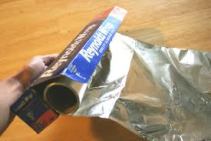 Aluminum foil is not only used in my thesis, but has a lot of applications in daily life. I have found some useful facts about aluminum foil.
Aluminum foil is not only used in my thesis, but has a lot of applications in daily life. I have found some useful facts about aluminum foil.
Aluminum foil is thin leaves less than 0.2mm thick. It is pliable and can be wrapped around objects. It is often laminated on other materials like plastics to be more useful as in our situation.
It replaces tin foils in 1950s. It is some times mistaken with metallised films which is plastic films coated with a thin layer of aluminum. And metallised films seems to be a better choice for my thesis.
Aluminum foil thicker than 0.025mm is impermeable to oxygen and water. Aluminum has a shiny side and a matte side due to production process. It’s said that the heat is kept out when shiny side is facing out and heat is kepts in when shiny face is facing in, but the difference is negaligibe without instrumentation.
Aluminum foil is mostly used as packaging. It is used in long-life packaging for food, drinks and pharmatheuticals as it is a total barrier for light and oxygen. It is also used to wrap food to preserve it like left food in fridge, take-away food and fast food as it can prevent ordor exchange. Aluminum foil is also ued in thermal insulation due to its high reflectivity, electromeganetic shielding and cooking like barbecue.
Some aluminum foil can be recycled but many aluminum laminates are not recycled due to difficulty in separating the components and low yield.
Aluminum foil is commonly used as foil containers and flexible packaging. In my thesis, aluminum foil is used to reduce radiation heat transfer as an important insulation method..
Here is the reference link: http://en.wikipedia.org/wiki/Aluminium_foil
http://www.uspackagingandwrapping.com/blog/Thickness-of-Aluminum-Foil.html



i have a question which you maybe can answer: why don’t they use tin foil anymore today ? Is it only because aluminum foil is cheaper to produce or are there also other reason?
Aluminum foil is cheaper and it’s more durable than tin foil.
I once heard that tin foil can also be toxic when it is heated and comes in contact with food. Do you have any idea if this is true?
“It tends to give a slight tin taste to food wrapped in it, which is a major reason it has largely been replaced by aluminium and other materials for wrapping food.” From Wiki.
But aluminum foil is said to be toxic when heated with food. “A recent study has shown that heat causes aluminum from the foil to leach out into foods in significantly harmful amounts.”
From http://saveourbones.com/stop-doing-this-with-aluminum-foil/
I know the major part of aluminium is recycled because of the energy intensive process of yielding pure aluminium from bauxite.
So could it be that the recycling of aluminium laminates is more energy intensive than making new aluminium or do we simply miss the infrastructure to perform this recycling?
Yes, it could be that the recycling of aluminum laminates is more energy intensive because of the separating and cleaning process.
Some recycle stations only accept clean aluminum.
I think we are in an experimenting phase when it comes to recycling laminates. Let’s hope these new techniques will be industrialized so they will become economically viable. In this article some of these techniques are described.
http://bestinpackaging.com/2012/02/02/recycling-packaging-material-with-an-aluminium-component/
Why do you prefer metallised films over aluminum foil? Is it too hard to attach aluminum directly to the core material?
And second, is a foil of for example 0.2mm thick strong enough to provide sufficient structural and bending stiffness?
Because metallised films have almost the same relectivity but light weight and low cost.
It’s not too hard to attach aluminum directly to the core material.
The foil alone is sure not strong enough, but when it’s attached to the panel, it’s strong enough with 0.1mm thick.